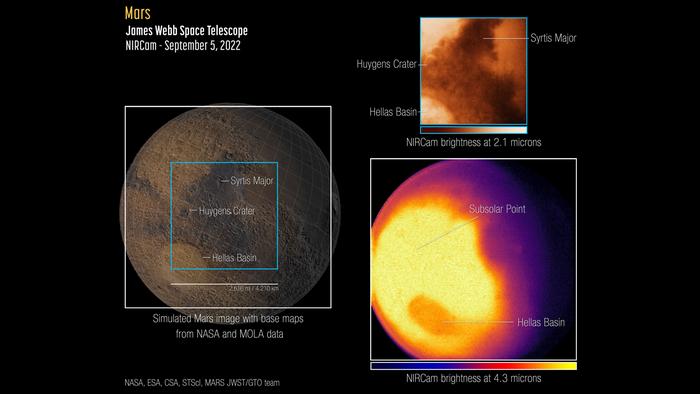Webb’s first images of Mars
Webb’s first images of Mars
The James Webb Space Telescope has taken its first images of Mars. They show part of its eastern, sunlit hemisphere. The close-up image on the left shows surface features such as Huygens Crater, the dark volcanic Syrtis Major and the Hellas Basin. The “heat map” on the right shows how Mars emits light when it loses heat.
Spinning wormholes
Webb recently peered into a wormhole in the mysterious-looking “Phantom Galaxy.” Scientists believe the dust lanes spiral towards an intermediate-mass black hole at the heart of the galaxy.
A galactic collision
The Cartwheel Galaxy, located about 500 million light-years from Earth, owes its appearance to a collision between a large spiral galaxy and a smaller galaxy not visible in this image. The Cartwheel snapshot provides insight into what happened to this galaxy in the past and how it will evolve in the future.
The invisible made visible
What might look like a glittering mountainous landscape is actually the edge of a young star-forming region called NGC 3324 in the Carina Nebula. The Webb Telescope image reveals for the first time areas of star birth that were previously invisible.
A lens to distant galaxies
SMACS 0723 is a galaxy cluster that has the ability to magnify and distort the light of objects behind it. This gives scientists a deep field view into extremely distant and faint galaxy populations.
Where stars are born
The Southern Ring Nebula is a planetary nebula — an expanding cloud of gas surrounding a dying star. It is nearly half a light-year in diameter, and the dimmer star at its center has been sending out rings of gas and dust for thousands of years in all directions. Nebulae are where stars are born.
- News
- News of Welcome Qatar Company
- Political News
- Qatar Football
- Qatar News
- Social News
- Sport News
- Technology News
- Top 10
- World News
Inside the cosmos: James Webb Space Telescope continues to dazzle





























